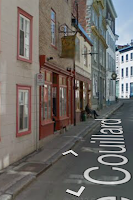This time of year, Vancouver is vibrant with blossoming trees. For those planning an outing, however, there is a practical problem about finding trees at their peak. Different varieties or "cultivars" bloom at different times. One day you'd be gasping at a pink forest and a couple of days later, groaning in disappointment at a pink gutter. It used to take lots of experience and luck to find the best trees.
My friend Chris and I took part, the next year, in another Festival Event, the Haiku Invitational Contest. To maximize inspiration, we decided to take our cameras out and write our poems as we drove around. I used a black-and-white printout of the map, stuffed in my pocket and soggy from the pouring rain.
We timed our 2007 expedition for the first "Shutdown Day". A Wikipedia article describes the event as: "Shutdown Day is a global Internet experiment whose purpose is to get people to think about how their lives have changed with the increasing use of the home computer, and whether or not any good things are being lost because of this.[1] The concept of the Shutdown Day project is to simply shutdown one's computer for one whole day each year, and become involved in other activities: outdoors, nature, sports, fun stuff with friends and family, just to remind yourself that there is a real world beyond the computer screen."
I was already writing this blog, which explored a similar theme, so during both springs of 2007-2008 I wrote a number of postings about Shutdown Day that you'll find in the index on the right. I re-read them myself last night, and watched my video again, embedded below. This bit of time-travelling has provided a literal "heads up" for me, right now, today.
Thanks to our Haiku project, Chris and I were among those that went back online (at midnight) and reported "Can" after successfully making it through a whole day without using our computers. Ironically, seven years later, I would now be one of the ones ticking the "Cannot" box. My smart phone never gets powered down. Here's an example of the difference this has made in my life.
It's a real improvement that the Vancouver Cherry Blossom Festival Map has morphed into an interactive custom Google Map which gives you directions to the "Best Blooms NOW" in over 1,300 locations. Any user can upload more locations of more trees and photos as they come into bloom, and comment in a forum. The screenshot below zooms into the trees which have been reported within a few blocks of my house.
However, I have a sneaking suspicion that for me now, in 2014, a cherry blossom poetry-writing expedition would involve a disproportionate amount of time walking blindly, hunched over my smart phone, reading the information about the location of the trees and watching the progress of the little blue dot that represents myself. The spirit of Shutdown Day suggests that, once in the general area, it could be fun to just wing it and look around. Cherry trees in full bloom might not be all that hard to spot with the naked eye -- they are those big, fragrant pink and white things.
Here is the video "Alternative Uses for Your Laptop", which launched the original Shutdown Day. This year the theme of the Festival's haiku activities is "meet your neighbour". It is time for me get out there and write another haiku.

















